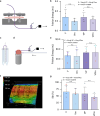Mucin Coatings Establish Multifunctional Properties on Commercial Sutures
- PMID: 40016087
- PMCID: PMC11921033
- DOI: 10.1021/acsabm.4c01793
Mucin Coatings Establish Multifunctional Properties on Commercial Sutures
Abstract
During the wound healing process, complications such as bacterial attachment or inflammation may occur, potentially leading to surgical site infections. To reduce this risk, many commercial sutures contain biocides such as triclosan; however, this chemical has been linked to toxicity and contributes to the occurrence of bacterial resistance. In response to the need for more biocompatible alternatives, we here present an approach inspired by the innate human defense system: utilizing mucin glycoproteins derived from porcine mucus to create more cytocompatible suture coatings with antibiofouling properties. By attaching manually purified mucin to commercially available sutures through a simple and rapid coating process, we obtain sutures with cell-repellent and antibacterial properties toward Gram-positive bacteria. Importantly, our approach preserves the very good mechanical and tribological properties of the sutures while offering options for further modifications: the mucin matrix can either be condensed for controlled localized drug release or covalently functionalized with inorganic nanoparticles for hard tissue applications, which allows for tailoring a commercial suture for specific biomedical use cases.
Keywords: antibacterial; bioactive glass; biopolymer; drug release; surgical site infection.
Conflict of interest statement
The authors declare no competing financial interest.
Figures






References
MeSH terms
Substances
LinkOut - more resources
Full Text Sources
Medical
